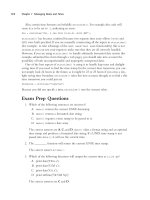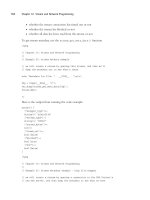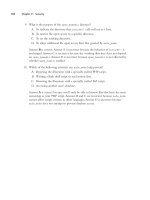Zend PHP Certification Study Guide- P11
Bạn đang xem bản rút gọn của tài liệu. Xem và tải ngay bản đầy đủ của tài liệu tại đây (122.91 KB, 20 trang )
184
Chapter 11 Security
9. What is the purpose of the
open_basedir
directive?
A. To indicate the directory that
include()
calls will use as a base.
B. To restrict file open access to a specific directory.
C. To set the working directory.
D. To allow additional file open access than that granted by
safe_mode
.
Answer B is correct. Answer A is incorrect because the behavior of
include()
is
unchanged. Answer C is incorrect because the working directory does not depend
on
open_basedir
. Answer D is incorrect because
open_basedir
is not affected by
whether
safe_mode
is enabled.
10. Which of the following activities can
safe_mode
help prevent?
A. Browsing the filesystem with a specially crafted PHP script.
B. Writing a Bash shell script to read session data.
C. Browsing the filesystem with a specially crafted Perl script.
D. Accessing another user’s database.
Answer A is correct because you’ll only be able to browse files that have the same
ownership as your PHP script. Answers B and C are incorrect because
safe_mode
cannot affect scripts written in other languages. Answer D is incorrect because
safe_mode
does not attempt to prevent database access.
12 7090 ch11 7/16/04 8:45 AM Page 184
Please purchase PDF Split-Merge on www.verypdf.com to remove this watermark.
12
Debugging and Performance
M
AKING MISTAKES IS HUMAN
, and so is fixing them. In your day-to-day program-
ming adventures, it’s inevitable to introduce bugs in your PHP code, especially when
you’re writing very complex applications with tens of thousands of lines of code spread
across tens of files.
When you’re prototyping an application, being able to avoid common programming
mistakes is important to ensure that your code will be well-written from the very start.
In this chapter, we’ll provide you with some guidelines on writing efficient code, debug-
ging faulty scripts, and identifying bottlenecks when performance becomes an issue for
both you and your clients.
Terms You’ll Need to Understand
n
Bug
n
Coding standard
n
Code readability
n
Comparison operators
n
Performance
n
Caching
n
Portability
Techniques You’ll Need to Master
n
Writing readable code
n
Proper commenting
n
Comparing heterogeneous data
n
Debugging
13 7090 ch12 7/16/04 8:44 AM Page 185
Please purchase PDF Split-Merge on www.verypdf.com to remove this watermark.
186
Chapter 12 Debugging and Performance
n
Identifying and preventing performance bottlenecks
n
Preventing performance issues
n
Improving database performance
n
Using content and bytecode caching
Coding Standards
Writing your code in a structured manner is, perhaps, the smartest decision you can
make. Although there aren’t any predefined coding standards that everyone in the pro-
gramming community recognizes as better than the rest, deciding from the very begin-
ning on a set of conventions will go a long way toward helping you make fewer
mistakes.
Documenting your code is particularly important.To make this job—probably at the
top of the Ten Most Hated Tasks of programmers worldwide—a bit easier, you can even
use one of the many automated tools available on the market, such as PHPDocumentor,
which can extract documentation directly from your code if you structure your com-
ments in a particular way.
Regardless of how you introduce them in your applications, good comments and
documentation will make sharing your code with other members of your team easier, as
well as make sure that you’ll remember what it does when you get back from that three-
week vacation. Remember, preventing bugs is much better than hunting for them.
Extra whitespace and empty lines, although unimportant as far as the functionality of
your code is concerned, can be an extremely valuable tool for writing better code:
if ($foo == ‘bar’)
{
$i = 0;
/**
* foreach loop, get the content out of it
*/
foreach ( …. )
{
}
}
By separating your code into logical groups, your source will be cleaner and easier to
read.Also, indenting each line according to the code block it belongs to helps you figure
out immediately what the structure of your script is.
13 7090 ch12 7/16/04 8:44 AM Page 186
Please purchase PDF Split-Merge on www.verypdf.com to remove this watermark.
187
Coding Standards
Flattening if Statements
Consider the following snippet of code:
if ($is_allocated)
{
if ($has_been_mangled)
{
if ($foo == 5)
{
print “foo is 5”;
}
else
{
print “You entered the wrong data!”;
}
}
else
{
return false;
}
}
else
{
return false;
}
As you can see, the many nested
if
statements here cause the code to look very busy
and difficult to read.An easy way to improve the situation consists of “flattening” your
if
statements so that you can achieve the minimum level of indentation without com-
promising either the functionality of your code or its performance.The preceding script,
for example, could be rewritten as follows:
if (!$is_allocated)
{
return false;
}
if (!$has_been_mangled)
{
return false;
}
if ($foo == 5)
{
print “foo is 5”;
13 7090 ch12 7/16/04 8:44 AM Page 187
Please purchase PDF Split-Merge on www.verypdf.com to remove this watermark.
188
Chapter 12 Debugging and Performance
}
else
{
print “You entered the wrong data!”;
}
This approach gives you a better structure with fewer levels of nesting so that your code
is easier to understand. Note that the type of operations performed is pretty much the
same as before—and the elimination of two
else
statements will make the code easier
to parse for the interpreter.
Splitting Single Commands Across Multiple Lines
One of the great things about PHP is that it doesn’t require you to write a single state-
ment all on one line of code. In fact, any statement can be split across an arbitrary num-
ber of lines without any change in its functionality—provided, of course, that the split
doesn’t take place in the middle of a text string.This is particularly useful when you have
a complex line of code that spans a large number of characters:
$db->query(“select foo,
bar,
mybar as foobar
from tbl1
where tbl1.mybar=’foo’”);
This database query is split over several lines.The main advantage here is that you can
immediately see what the query does, which tables are involved, and which conditions
you are placing in the
where
clause. If the same query had been placed all on the same
line, understanding its purpose would have taken a lot more effort, and the risk of intro-
ducing new bugs by modifying it would have been greater.
Concatenation Versus Substitution
If you are inserting data into a long string—such as a database query—you can use the
concatenation operator, but doing so often limits your ability to read the query properly:
$db->query
(“insert into foo(id,bar)
values(‘“.addslashes($id).
“‘,’”.addslashes($bar).”’)”);
On the other hand, you could just use one of the
printf()
functions to do the job for
you:
$db->query(sprintf(“insert into foo(id,bar) values(‘%s’,’%s’)”,
addslashes($id),
addslashes($bar)
));
13 7090 ch12 7/16/04 8:44 AM Page 188
Please purchase PDF Split-Merge on www.verypdf.com to remove this watermark.
189
One Equal, Two Equals, Three Equals
As you can see, the entire statement is now a lot easier to read, although you will lose
some performance by switching to
sprintf()
from the concatenation operator, which is
native to the PHP interpreter and doesn’t require the execution of any external libraries.
The literals in the string passed to
sprintf()
will be substituted with the values of the
parameters passed afterwards in the order in which they appear in the call. Combined
with the ability to split your commands over several lines, this approach can enhance
readability to a large degree.
Choose Your Opening Tags Carefully
Mixing PHP and HTML code is one of the characteristics of PHP that make it both
easy to use and powerful, although it’s easy to abuse this capability and come up with
code that is difficult to read.
When writing code for an application that could run on heterogeneous systems, it’s
always a good idea to be very careful about which opening tag styles you use. In Chapter
1,“The Basics of PHP,” we mentioned that there are several of them, but only the
canonical tags
<?php ?>
are fully portable. Short tags (which include the echo tag
<?=
)
and ASP tags can all be turned off through PHP configuration directives.
Thus, the following
<?php print “Testing 1 2 3” ?>
is longer than
<?= “Testing 1 2 3” ?>
But not quite as portable. Note, also, that there is a subtle difference between
and
echo
. Although they are both language constructs, the former acts as a function—mean-
ing that it actually returns a value (always a Boolean
True
)—whereas the latter does not.
Thus, the following code is valid, although quite pointless:
<?php echo print (10) ?>
One Equal, Two Equals, Three Equals
How often did you write the following code?
if ($a = 5)
{
print “a is 5”;
}
If you’re like most programmers, the answer is an unfortunate “often.”The problem here
is caused by the fact that the
if
statement allows for any operations to take place inside
its condition—including assignments.Thus, the preceding line is not technically incor-
rect, but it’s obviously not what the author intended to perform, as it will always be eval-
uated to true, making the
if
statement pointless and, what’s worse, changing the value
of
$a
.
13 7090 ch12 7/16/04 8:44 AM Page 189
Please purchase PDF Split-Merge on www.verypdf.com to remove this watermark.
190
Chapter 12 Debugging and Performance
Clearly, the statement should have been written as follows:
if ($a == 5
{
print “a is 5”;
}
In this case, the condition is a comparison operator, and it will be evaluated as true only
if the value of
$a
is
5
.
There is, luckily, a very easy way to avoid this mistake once and for all, without any
possibility of ever slipping again: make sure that the condition is written in such a way
that it cannot possibly be misinterpreted:
if (5 == $a)
{
print “a is 5”;
}
With this approach, if you mistakenly only use one equal sign instead of two, as in
5 =
$a
, the interpreter will print out an error because you can’t assign anything to an imme-
diate value. If you make a habit of writing all your conditions this way, you will never
fall in the assignment trap again!
There’s Equal and Equal
As we mentioned in Chapter 1, PHP is a loosely typed language.This means that, under
the right circumstances, it will automatically juggle data types to perform its operations
according to how programmers are most likely to want it to.
There are scenarios, however, in which this is not a desirable approach, and you want,
instead, PHP to be strict and literal in the way it compares data. Consider, for example,
what would happen if you were dealing with information coming from a patient’s med-
ical record. In this situation, you’ll want to make sure that nothing is left to chance and
that PHP doesn’t attempt to interpret user input in too liberal a way.
Generally speaking, it’s always a good idea to use the identity operators (
===
and
!==
)
whenever you know that a value has to be of a certain type:
if ($a !== 0) {
echo ‘$a is not an integer zero’;
}
Testing for Resource Allocation
One of the most common mistakes that causes code to become unreliable consists of
using external resources without ensuring that they are available. For example, look at
the following code:
13 7090 ch12 7/16/04 8:44 AM Page 190
Please purchase PDF Split-Merge on www.verypdf.com to remove this watermark.
191
Ternary Operators and if Statements
$res = mysql_query(“select foo from bar”);
while ($row = mysql_fetch_array($res))
{
print $row[‘foo’].”<br>”;
}
See what’s wrong? The author doesn’t test for the query’s failure before moving on to
perform other tasks that use the resource returned by
mysql_query()
.The query could
fail for a number of reasons, even though it is syntactically correct—for example, the
server might be unavailable, or there could be a network interruption. What’s worse in
this particular case, the MySQL extension does not cause a fatal error if a query cannot
be executed.Therefore, the script moves on, and a cascade of additional problems could
be caused by this initial blunder.
If, on the other end, error conditions are properly tested for, this issue doesn’t even
present itself:
if (!$res = mysql_query(“select foo from bar”))
{
/**
* no valid result, log/print error, mysql_error() will tell you
*/
}
else
{
while ($row = mysql_fetch_array($res))
{
print $row[‘foo’].”<br>”;
}
}
It’s undoubtedly hard to write an
if
statement every time you execute a query—but
also necessary if you are serious about error management.To make things a bit easier on
yourself (and your entire team), you could adopt one of the many abstraction layers
available or write one yourself.This way, the actual error management can be performed
in a centralized location (the abstraction layer), and you won’t have to write too much
code.
It’s important to keep in mind that this process is required whenever you interact
with an external resource, be it a database, a file, or a network connection.
Starting with PHP 5, you can use other error-control structures known as exceptions.
However, remember that these are not available in PHP 4 and, therefore, cannot be used
to solve a problem that appears in the exam.
Ternary Operators and
if
Statements
if
statements are necessary control structures for all but the simplest of PHP scripts. As a
result, sometimes they will tend to be very complex, even if you nest them on various
levels.
13 7090 ch12 7/16/04 8:44 AM Page 191
Please purchase PDF Split-Merge on www.verypdf.com to remove this watermark.









